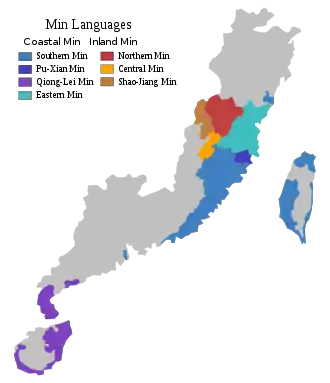| Putian | |
|---|---|
| Sing-iú-uā / 仙遊話 | |
| Native to | Southern China |
| Region | Xianyou, Putian, Fujian |
Early forms | |
| Language codes | |
| ISO 639-3 | – |
| Glottolog | xian1252 |
| Linguasphere | 79-AAA-ida |
| Xianyou dialect | |||||||||||
|---|---|---|---|---|---|---|---|---|---|---|---|
| Traditional Chinese | 仙遊話 | ||||||||||
| Simplified Chinese | 仙游话 | ||||||||||
| |||||||||||
The Xianyou dialect (Pu-Xian Min: Sing-iú-uā / 仙遊話; IPA: [ɬiŋ˨˨ iu˨˦ ua˨˩]) is a dialect of Pu-Xian Min Chinese spoken in Xianyou, Putian in the southeast coast of Fujian province, China.
Phonology
The Xianyou dialect has 15 initials, 45 rimes and 7 tones.
Initials
| Bilabial | Alveolar | Lateral | Velar | Glottal | ||
|---|---|---|---|---|---|---|
| Stop | Unaspirated voiceless | p 巴 | t 打 | k 家 | ʔ 烏 | |
| Aspirated voiceless | pʰ 彭 | tʰ 他 | kʰ 卡 | |||
| Nasal | m 麻 | n 拿 | ŋ 雅 | |||
| Fricative | Voiceless | ɬ 沙 | h 下 | |||
| Voiced | β* | ɣ* | ||||
| Affricate | Unaspirated voiceless | ts 渣 | ||||
| Aspirated voiceless | tsʰ 査 | |||||
| Approximant | l 拉 | |||||
Rimes
| a 鴉 | ã 平 | au 拗 | aŋ 江 | aʔ 壓 | |
| ɒ 奥 | ɒ̃ 泛 | ɒŋ 王 | ɒʔ 屋 | ||
| o 科 | ɔu 烏 | ||||
| e 裔 | ai 愛 | ɛŋ 煙 | ɛʔ 黑 | ||
| ø 改 | |||||
| ŋ 伓 | |||||
| i 衣 | ĩ 反 | iu 油 | iũ 張 | iŋ 引 | iʔ 益 |
| ia 夜 | iã 丙 | ieu 要 | iɛŋ 鹽 | iɛʔ 葉 | |
| u 夫 | ui 位 | uĩ 風 | |||
| ua 画 | uoi 歪 | uã 搬 | uaŋ 碗 | uoʔ 活 | |
| y 余 | ỹ 頓 | yŋ 恩 | yʔ 役 | ||
| ya 鵝 | yã 然 | yøŋ 羊 | yøʔ 藥 |
Tones
| No. | 1 | 2 | 3 | 4 | 5 | 6 | 7 |
|---|---|---|---|---|---|---|---|
| Tones | dark level 陰平 |
light level 陽平 |
rising 上聲 |
dark departing 陰去 |
light departing 陽去 |
dark entering 陰入 |
light entering 陽入 |
| Tone contour | ˥˦˦ (544) | ˨˦ (24) | ˧˧˨ (332) | ˥˨ (52) | ˨˩ (21) | ʔ˨ (ʔ2) | ʔ˦ (ʔ4) |
| Example Hanzi | 詩巴 | 時爬 | 始把 | 試霸 | 寺罷 | 濕北 | 實拔 |
Assimilation
| Coda of the Former Syllable |
Initial of the Latter Syllable |
Assimilation | Coda of the Former Syllable |
Initial of the Latter Syllable | |
|---|---|---|---|---|---|
| Group A | Open syllable | /p/, /pʰ/ | → | remain unchanged | /β/, /ɣ/ |
| /t/, /tʰ/, /ts/, /tsʰ/, /ɬ/ | /l/ | ||||
| /k/, /kʰ/, /h/ | /ɣ/ | ||||
| Group B | /-ŋ/ (nasal coda) | /p/, /pʰ/ | /-m/ | /m/ | |
| /t/, /tʰ/, /ts/, /tsʰ/, /l/, /ɬ/ | /-n/ | /n/, remain unchanged | |||
| /k/, /kʰ/, /h/, null initial | remain unchanged, or /-n/ | /ŋ/, /n/ | |||
| /m/, /n/, /ŋ/ | /-m/, /-n/, /-ŋ/ | remain unchanged | |||
| Group C | /-ʔ/ (glottal coda) | /p/, /pʰ/, /m/ | /-p̚/ | remain unchanged | |
| /t/, /tʰ/, /ts/, /tsʰ/, /ɬ/, /l/, /n/ | /-t̚/ | ||||
| /k/, /kʰ/, /ŋ/, /h/ | /-k̚/ | ||||
| null initial | /-ʔ/ | ||||
| Group E | Open syllable | /m/, /n/, /ŋ/ | nasalization | remain unchanged | |
| nasalized rime | nasalization | ||||
| nasalized rime | remain unchanged | /n/ | |||
Tone sandhi
The Xianyou dialect has extremely extensive tone sandhi rules: in an utterance, only the last syllable pronounced is not affected by the rules.
The two-syllable tonal sandhi rules are shown in the table below (the rows give the first syllable's original citation tone, while the columns give the citation tone of the second syllable):
| dark level 544 |
light level 24 |
rising 332 |
dark departing 52 |
light departing 21 |
dark entering ʔ2 |
light entering ʔ4 | |
| dark level 544 |
24 | 22 | 24 | 22 | |||
| light level 24 |
22 | 44 | 52 | 22 | |||
| rising 332 |
24 | 44 | 24 | ||||
| dark departing 52 |
44 | 33 | 44 | 52 | 44 | ||
| light departing 21 |
22 | 44 | 52 | 22 | |||
| dark entering ʔ2 |
ʔ4 | ||||||
| light entering ʔ4 |
ʔ2 | ʔ4 | ʔ2 | ||||
Notes
References
- ↑ Mei, Tsu-lin (1970), "Tones and prosody in Middle Chinese and the origin of the rising tone", Harvard Journal of Asiatic Studies, 30: 86–110, doi:10.2307/2718766, JSTOR 2718766
- ↑ Pulleyblank, Edwin G. (1984), Middle Chinese: A study in Historical Phonology, Vancouver: University of British Columbia Press, p. 3, ISBN 978-0-7748-0192-8
- ↑ Hammarström, Harald; Forkel, Robert; Haspelmath, Martin; Bank, Sebastian (2023-07-10). "Glottolog 4.8 - Min". Glottolog. Leipzig: Max Planck Institute for Evolutionary Anthropology. doi:10.5281/zenodo.7398962. Archived from the original on 2023-10-13. Retrieved 2023-10-13.
- Compilation Commission of Chorography of Xianyou County 仙游县地方志编纂委员会 (1995). Xianyou xianzhi 仙游县志 ["Chorography of Xianyou County"]. Vol. 34. Beijing: Fangzhi chubanshe 方志出版社 ["Chorography Press"]. ISBN 7-80122-007-2.
This article is issued from Wikipedia. The text is licensed under Creative Commons - Attribution - Sharealike. Additional terms may apply for the media files.
